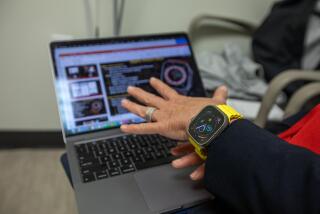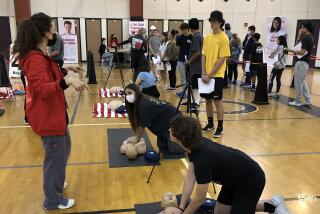Giving Doctors a Helping Hand : Medicine: Invention reduces risk of being exposed to AIDS virus during treatment.
His first invention helped patients breathe easier. His newest may do the same for doctors.
Sol Weiss is a family physician in Reseda who spends his days treating ordinary aches and pains and his nights tinkering with unusual medical prototypes in his garage.
His latest gadget helps keep doctors from accidentally exposing themselves to the AIDS virus when giving emergency treatment to victims of car crashes and other mishaps.
It is a pocket-size tool that will let doctors tend to crushed chests, collapsed lungs and internal bleeding without touching broken bones with their hands, Weiss said.
It uses a syringe and clamp system to guide an angled, hollow probe into the chest cavity to help reinflate collapsed lungs. The device replaces the traditional tool for such procedures: a doctor’s finger.
That minimizes the danger of medics nicking their fingers on hidden bone fragments and possibly picking up the human immunodeficiency virus from accident victims’ blood.
Doctors nervous over the growing AIDS epidemic are lining up for the federally approved, $100 device--which Weiss plans to begin delivering by the end of this month.
“I don’t think anyone in emergency medicine isn’t concerned about AIDS,” said Dr. Richard Sanders, a Creole, La., physician who has ordered a kit for the 22-bed hospital where he is the only physician. He said he frequently treats chest injuries caused by oil field accidents and traffic crashes. He also has several AIDS patients.
A larger supply of kits is being sought for the busy 647-bed St. Joseph Medical Center in Burbank. They will be available for emergency room doctors who may be relatively inexperienced at handling severe chest injuries.
“It looks like something worth trying,” said Dr. Raymond Scharf, St. Joseph’s chief of thoracic surgery. “If a rookie is putting in a chest tube, he might (cut) himself. We have instances where no one who is skilled is available.”
The device was characterized as “very, very timely” by AIDS activists, who said there have been situations across the country where emergency treatment has been delayed because doctors were worried about HIV exposure.
“There’s a lot of fear out there, and not inappropriately,” said Dr. Mervyn F. Silverman, president of the San Francisco-based American Foundation for AIDS Research. “The last thing we want is for anyone to be reluctant to treat someone.”
Other medical experts are more reserved, although they acknowledge that nicked fingers can be an emergency room hazard.
“There’s been so much concern about coming into contact with people’s body fluids that I’m sure all kinds of devices occur to people to remove you farther and farther from the patient,” said Dr. Shirley Fannin, chief of communicable disease control for the Los Angeles County Department of Health Services. “But you have to ask yourself: Do they really replace touch?”
Weiss, 61, credits a numbing encounter with a 5-year-old boy for helping prompt development of the chest device. He said his seven-piece “Nu-Thor” kit is a refinement of equipment concocted earlier for emergency use on the throat.
According to Weiss, he was working in 1964 at a Canoga Park hospital’s emergency room when the boy was rushed in. He was choking on a bite-size chunk of hot dog.
A tracheotomy--an incision through the throat to form an air hole--was needed to keep the boy breathing, Weiss decided. He was worried about his ability to do the procedure: An improper cut could kill or permanently injure the boy.
“I’d done tracheotomies on adults, but never on a child. I was scared--almost in a state of shock. It was almost overwhelming,” Weiss said.
As he prepared to make the incision, the boy suddenly coughed up the food. Shaken, Weiss went home and started sketching ideas for a blade-equipped breathing tube system that could automatically make proper airway incisions on children.
Fifteen years later, after doggedly pursuing state and federal medical regulators and medical equipment makers, Weiss had perfected the design and decided to manufacture the device, called “Nu-Trake.”
He mortgaged his home, opened a tiny Northridge production plant and put his wife, Marsha, in charge of making child and adult sizes. After a slow start, more than 60,000 devices have been sold.
The success of the kits did not surprise Weiss. The reaction of other doctors did: Some wondered if similar technology could be applied to the chest.
“When we’d go to medical meetings, doctors would come up and say there was a lot of apprehension in caring for HIV-positive patients,” he said. Although they have done no advertising and have yet to ship their first chest kit, medics have ordered more than 1,000, Marsha Weiss said.
“Doctors are scared to death,” she said. “At one time, you used to just think about protecting the patient. Now, you have to think about protecting the doctor.”
Sol Weiss said he does not remember the name of the 5-year-old whose choking spell turned him into an inventor. The hospital’s logs from 26 years ago have been discarded.
“If I could, I’d thank him,” he said.
“I think a lot of other people in medicine would thank him too.”







